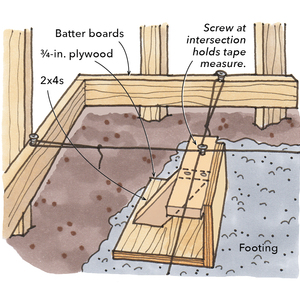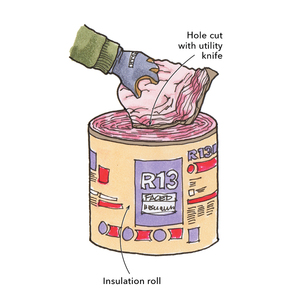entryway rebuild – needing to support ceiling joists
Below are some pictures of my entryway. Originally, there was an opening the same size as the front door, but there was never a door here. I tore into the walls to remove rotten wood – caused by leaking roof that has been repaired. I would like to remove the walls and header for the entryway, but that brings up the issue of supporting the ceiling and roof joists which had originally set on the main wall top plate which sat above the doorway header.
Can I do away with the top plates above the entryway opening and put 2 2×6’s on edge extending to set on top of the top plate on either side of the entryway, nail the ends of this header into a joist setting on the top plate either side of the opening and use metal joist hangers to attach the joists above the opening to the 2×6’s?
This is a load bearing 2×4 wall and the new opening will be 64″



















Replies
Unfortunately, the captions on your last picture didn't survive.
Basically, the captions showed what I want to remove. The boxes on the left and right midways up the picture shows the little walls to be removed. The caption box in the middle right top shows the joists to be supported, the box below that shows the top plate to be removed and the middle left top box shows the header to be removed.
j
The pictures have me a bit confused, which wall are you talking about?
What is the load you are trying to carry with this dbl 2x6 header?
What will be below this "load carrying" header? What will the point loads at either end be sitting on?
The white 2x4's are the outside edge of the area to be removed. Beside each vertical white board are 3 2x4's which is where I would have the 2x6's (1 or 2) setting on top of on the top plate.
The header would give an attachment point for the ceiling joists which were sitting on top of the rotten top plate. The roof rafters end here as well, but were not attached to the top plate. The roof rafters (2x6's) are nailed to another 2x4 that sits on edge on the top plates of the walls that extend toward the front door.
I'm trying to do away with the doorway and have an open space. So, below the new header would be sheet rock to make the entryway ceiling flush with the middle room ceiling.
Header size
is dependant on the load being carried.
Size of that roof and the load you would build to in your area will decide the header size. At 5'4", 2-2x6 MIGHT be enough, but doesn't handle much.
Have you compared your structure and loads to a chart on header spans?
A good publication was available at the Canadian Wood Council site- http://www.cwc.ca
Includes both canadian and us information.
You need a little more detail than "it will hold up the ceiling and roof".
What is under the subfloor where those 3 2x4's in the wall sit?
Best of luck.
Note that the king studs were deemed adequate to hold up the opening before. No reason to believe that they are now inadequate, assuming that the structure was more or less built to code in the first place. (Though it would be wise to check for rot underneath.)
Underneath everything is concrete, this is a single story earth contact, so it's sitting on the slab. It's an outside wall (well sort of - entryway). Not sure how to figure the load - still looking up header charts. Rot has been removed.
DanH, I think that's what I'm talking about - flush beam that is.
There's 3 or 4 different colored framing members in those ......
walls and ceilings.
Which was there first, what was added, what was changed?
There's no header that I can make out, looked like the back of plywood across that opening, then in another shot, there's what appears to be a 2xsomething, plated top and bottom.
Sorry Dan, I could tell you what to do if I was there looking at it. But not with what I see here.
Probably just me, fresh in from battling the driving hoards going home from holiday.
This is what I saw when I cut away the sheet rock. I haven't added anything and I am the second owner. The previous owner was the builder, and carpentry wasn't his first line of work either. The different colored framing is partly due to him recycling lumber that he picked up here and there. That wood you're calling plywood, is indeed a 2x6.
Order of material from opening upward:
Stained 1x framing opening
Sheet rock (looked like he might have planned on having the opening rocked, then changed his mind and framed it in wood)
2x4
plywood (spacer?)
2x6 on edge
Twin top plate
ceiling joists & roof joists - both 2x6
To me it looks like an opening for a door with sidelights. Don't know if the builder planned for sidelights and then changed his mind, or there once was a door with sidelights before the new entryway was built. There would be no point in the triple king studs if a wider opening weren't planned.
In any event, if the floor is concrete then there should be no serious concern about it's bearing capacity for this case.
I think what you're talking about is called a "flush beam". Here is an article on installing a larger one: http://homeremodelersstore.com/web_articles/framing/install%20flush%20beam.pdf
Your short one should be much simpler.
You do need to be sure it's sized right (I don't know if a double 2x6 is enough), and you need to be sure that it fully bears on the triple 2x4 king studs on each side of the opening.
When removing a bearing wall section, you need to build a temporary bearing wall to take the load while you take out and replace/reconfigure the opening. Usually this is done by building a temp wall 24" away from the existing - giving you enough room to work. Do an archive search on JLC and FHB to see some examples.
If you look at the last two pictures he's already got that.
Kind of looked like an enclosed entryway to me - hard to tell the depth of that open stud wall.
The entryway is on the other side of the door opening under discussion.
I have read this thru to now.
you CAN replace this with a flush beam sized to handle the load, but since you don't give the load aprticulars, there is no way to know what size the header needs to be.
We could ASSUME that if the existing single 2x6 carried the load all this time, that a double might do it for a slightly longer span.
Rather than assume, it would be better for you to say how long the rafters span and what the snow load requirements are in your area
(Undeleted)
There are two joists bearing near the center of the proposed beam, and two near the ends that can be mostly discounted. The load from the entry area can be largely discounted (on acounta being so small), so you've got basically the (nearly) full weigh of two joists plus maybe the equivalent of a third with the "discounted" stuff. So (given that the beam will only need to be about 6 feet long, vs the 8-12 foot length of the joists) a doubled member of the same height is "almost guaranteed" to handle the load, and going 2" taller (going from 2x6 to 2x8 adds 50%) would be as certain as you can get (to the extent that the existing framing is sufficient in the first place).
why di you assume 8-12 foot length and why ignore possible roof loads?
It would be at least eight, judging from the picture, and a 2x6 can't span more than about 12. I ignore the roof load because I can, from this distance. (From the pictures there are no roof members bearing on the opening, so any possible roof load is being carried by the 2x6s -- though I'll admit that it's a little hard to tell for certain.)
late in the conversation but...
I don't see a header in your original set of images. Code in my area would have called for double kings, triple jacks on the studs, 2x10 on the header that isn't there, on the opening size I see.
I think your flush beam idea will work; pay attention to bearing points.
-mark